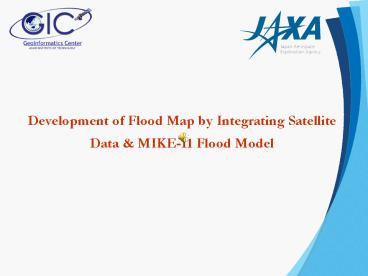Development of Flood Map by Integrating Satellite Data PowerPoint PPT Presentation
1 / 20
Title: Development of Flood Map by Integrating Satellite Data
1
Development of Flood Map by Integrating Satellite
Data MIKE-11 Flood Model
2
Introduction
- Bangladesh devastating flood generally occurs in
the three major basins Jamuna, Padma and Meghna.
- FFWC forecasting performance was around 60-80
for maximum 48-hour interval (FFWC 2006). - Accuracy of model results is not very impressive
due to lack of updated Digital Elevation Model
(DEM). The current DEM is coarse, 900 meter
resolution, not sufficient enough to represent
flat terrain of Bangladesh. - One of the important task is to develop better
DEM to increase the model prediction - The study with satellite images to develop
high-resolution DEM is therefore highly
desirable.
Flood Depth Map Source FFWC
3
Objectives
- Comparative Studies on MIKE 11 model generated
flood mapping and Satellite based Flood
Mapping. - DEM Generation from Satellite Data (ASTER and
SRTM), and in future ALOS-PRISM data. - Improvement of MIKE 11 model generated Flood Map
quality by using Optimum DEM. - Attempt to use ALOS high-resolution PRISM data to
extract building and roads
4
Location of the Study Area
5
Methodology Main Flow Chart
Satellite Data
Flood Map from Satellite (ASTER, 20 October2004)
Flood Map from MIKE 11 (20 October2004)
Hydrometeorological Data
Extracting Buildings roads
DEM (SRTM, ASTER)
MIKE 11 Process
Comparative Studies
MIKE 11 Flood Map
Building Road maps from ALOS PRISM ( May 2006)
Improved Flood Map
6
Data Used in the Mini-Project
7
Satellite images ASTER VNIR Dry Season
Source Ministry of Economy Trade and Industry
(METI), Japan Date of Acquisition 19 May 2006
Source Ministry of Economy Trade and Industry
(METI), Japan Date of Acquisition 01 February
2002
8
Satellite images ASTER VNIRRainy Season
Source Ministry of Economy Trade and Industry
(METI) Date of Acquisition 20 October 2004
9
Satellite images ALOS PRISM
Source Japan Aerospace Exploration Agency
(JAXA) Date of Acquisition 21 October 2006
(Left), 19 November 2006 (Right)
10
Satellite images Shuttle Rader Topography
Mission (SRTM) 2000
Source Ministry of Economy Trade and Industry
(METI), Japan Date of Acquisition 20 October
2004
11
Results Comparison of ASTER image and flood map
created by MIKE 11 model
MIKE 11 Model Generated Flood Map
ASTER Image Generated Flood Map
12
Results SRTM DEM of the Study area excluding
river network
Resolution90 m
Source National Aeronautics and Space
Administration (NASA) Date of Acquisition 2000
13
Results DEM of same area extracted from
existing DEM
Resampled 900m to 90m
Source Flood Forecasting and Warning Center
(FFWC) Date of Acquisition 2004
14
Results Flood map by integrating existing DEM
and MIKE 11 flood model
Source NASA, FFWC Date of Acquisition 2000,
2004
15
Results Flood map by integrating New DEM and
MIKE 11 flood model
Source NASA, FFWC Date of Acquisition 2000,
2004
16
Results DEM from ASTER image and GPS points
Source Ministry of Economy Trade and Industry
(METI), Japan Date of Acquisition 19 May 2006
17
Results Building Location extracted from ALOS
PRISM
Source Japan Aerospace Exploration Agency
(JAXA) Date of Acquisition 21 October 2006
(Left), 19 November 2006 (Right)
Legend
18
Results Road Network extracted from ALOS PRISM
Source Japan Aerospace Exploration Agency
(JAXA) Date of Acquisition 21 October 2006
(Left), 19 November 2006 (Right)
Legend
Road Network
19
Conclusions
- Current 900m resolution DEM is not suitable to
produce inundation map with sufficient accuracy
as it shows significant flooded area, 57 of the
study area even in the dry period, i.e. July
2006. - SRTM-DEM appeared acceptable to generate flood
map using MIKE-11 flood model during the dry
period, that is July 2006. However, further
verification is necessary estimating during a
flood. - DEM from ASTER images showed unreasonable
elevations in spite of calibration with ground
observations. This could be due to excessive
water features in the image creating problems in
image matching, or limitation of the software. - ALOS PRISM was extremely good for extraction of
road network and building location.
20
Recommendations
- Need to gather PRISM images from JAXA covering 50
to 60 more than study area especially in the
upstream region. - Recent satellite Images from JAXA of two distinct
time (dry/flood period) are necessary for - DEM generation (ALOS-PRISM)
- Extent of flood (ALOS-PALSAR)
- High-resolution DEM from ALOS-PRISM data will
improve the accuracy of model prediction. - ALOS PRISM data could use to develop a detail
infrastructure map of the study area to identify
element at risk during a flood event. Dry season
images of ALOS-PRISM would be highly suitable for
creation of infrastructure database.

